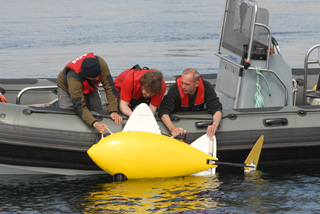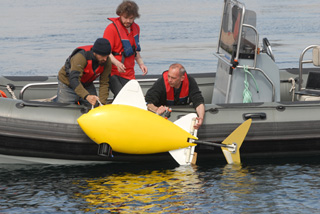Navigation
Intelligent Robotic Fish Detect Pollution
SHOAL, the pan-European ICT project, part funded by the EU, has successfully developed and delivered intelligent robotic fish capable of working together to detect and identify pollution in ports and other aquatic areas.
 If the robotic fish try to find the source of the pollution they find: If the robotic fish try to find the source of the pollution they find, as soon as they have determined the source they will immediately contact the port via the ultrasonic communications so that the port can take any appropriate measures to deal with stopping the source of the pollution. Photograph courtesy of SHOAL.
If the robotic fish try to find the source of the pollution they find: If the robotic fish try to find the source of the pollution they find, as soon as they have determined the source they will immediately contact the port via the ultrasonic communications so that the port can take any appropriate measures to deal with stopping the source of the pollution. Photograph courtesy of SHOAL.
SHOAL, the pan-European ICT (Information and Communication Technology) project, part funded by the EU, has successfully developed and delivered intelligent robotic fish capable of working together to detect and identify pollution in ports and other aquatic areas.
Luke Speller, Project Leader of SHOAL and Senior Research Scientist at BMT Group commented: “SHOAL has introduced the capability of cutting the detection and analysis of pollutants in sea water time from weeks to just a few seconds. Chemical sensors fitted to the fish permit real-time in-situ analysis, rather than the current method of sample collection and dispatch to a shore based laboratory. Furthermore, the Artificial Intelligence which has been introduced means that the fish can identify the source of pollution enabling prompt and more effective remedial action.”
 The choice of a robotic fish is not an aesthetic one but a design choice.: The design of a robotic fish is a very maneuverable, efficient, low noise solution. The robotic fish have an incredibly small turning circle allowing them to navigate quickly in ports both to find pollution and avoid ships and the port infrastructure. It's also low noise so as to not disturb the environment when outside of busy ports. Photograph courtesy of SHOAL.The last 3 years has seen no less than 5 key areas of major development. These include Artificial Intelligence, Robotic Design, Chemical Analysis, Underwater Communication and Hydrodynamics.
The choice of a robotic fish is not an aesthetic one but a design choice.: The design of a robotic fish is a very maneuverable, efficient, low noise solution. The robotic fish have an incredibly small turning circle allowing them to navigate quickly in ports both to find pollution and avoid ships and the port infrastructure. It's also low noise so as to not disturb the environment when outside of busy ports. Photograph courtesy of SHOAL.The last 3 years has seen no less than 5 key areas of major development. These include Artificial Intelligence, Robotic Design, Chemical Analysis, Underwater Communication and Hydrodynamics.
Artificial Intelligence has been developed and introduced to enable the fish to manage multiple problems including avoiding obstacles, knowing where to monitor pollution, finding the source of a pollution, maintaining communication distance from the other fish and returning to be recharged. Each individual robotic fish has an array of sensors and external information that will allow it to navigate the environment.
 The fish work together much like a group of people would work together to accomplish a task.: If you were trying to accomplish a task everyone in the group knows something about the situation, through talking they are able to share information and while not everyone knows everything that is going on they are still able to accomplish the task between them. Likewise the fish do not all know the whole picture of the pollution but between them they know much more and through the communication they are able to work together. Photograph and all image text courtesy of SHOAL.The fish can map where it is, where it needs to go, what samples it has taken and where from and what the chemical composition of the samples are, as well as communicating all of this back through shallow water to a base station, the other fish and the user interface.
The fish work together much like a group of people would work together to accomplish a task.: If you were trying to accomplish a task everyone in the group knows something about the situation, through talking they are able to share information and while not everyone knows everything that is going on they are still able to accomplish the task between them. Likewise the fish do not all know the whole picture of the pollution but between them they know much more and through the communication they are able to work together. Photograph and all image text courtesy of SHOAL.The fish can map where it is, where it needs to go, what samples it has taken and where from and what the chemical composition of the samples are, as well as communicating all of this back through shallow water to a base station, the other fish and the user interface.
Significantly, the robotic fish have been developed to blend into the marine environment in such a way that marine life is neither disrupted nor impacted in any negative way by their presence, but carries on naturally.
Luke Speller continued: “SHOAL has seen the coming together of scientists from across Europe to create a system that could not have been achieved without collaboration between different disciplines. One of the greatest achievements of SHOAL is getting robots running outside the lab and in the harsh, dynamic conditions of the sea.
Autonomously exploring and investigating the harbor, the fish can work together to monitor and track down sources of pollution.”
SHOAL is a consortium of 6 European organizations including: BMT Group - the project leaders and responsible for Artificial Intelligence; the University of Essex responsible for Robotic Development; the Tyndall National Institute responsible for the Chemical Sensors; the University of Strathclyde responsible for Hydrodynamic Research; Thales Safare responsible for the Communication Network and the Port Authority of Gijon - the testing port.
This news is from SHOAL, 23 May 2012.
Search
Latest articles
Agriculture
- World Water Week: Healthy ecosystems essential to human health: from coronavirus to malnutrition Online session Wednesday 24 August 17:00-18:20
- World Water Week: Healthy ecosystems essential to human health: from coronavirus to malnutrition Online session Wednesday 24 August 17:00-18:20
Air Pollution
- "Water and Sanitation-Related Diseases and the Changing Environment: Challenges, Interventions, and Preventive Measures" Volume 2 Is Now Available
- Global Innovation Exchange Co-Created by Horizon International, USAID, Bill and Melinda Gates Foundation and Others
Biodiversity
- It is time for international mobilization against climate change
- World Water Week: Healthy ecosystems essential to human health: from coronavirus to malnutrition Online session Wednesday 24 August 17:00-18:20
Desertification
- World Water Week: Healthy ecosystems essential to human health: from coronavirus to malnutrition Online session Wednesday 24 August 17:00-18:20
- UN Food Systems Summit Receives Over 1,200 Ideas to Help Meet Sustainable Development Goals
Endangered Species
- Mangrove Action Project Collaborates to Restore and Preserve Mangrove Ecosystems
- Coral Research in Palau offers a “Glimmer of Hope”
Energy
- Global Innovation Exchange Co-Created by Horizon International, USAID, Bill and Melinda Gates Foundation and Others
- Wildlife Preservation in Southeast Nova Scotia
Exhibits
- Global Innovation Exchange Co-Created by Horizon International, USAID, Bill and Melinda Gates Foundation and Others
- Coral Reefs
Forests
- NASA Satellites Reveal Major Shifts in Global Freshwater Updated June 2020
- Global Innovation Exchange Co-Created by Horizon International, USAID, Bill and Melinda Gates Foundation and Others
Global Climate Change
- It is time for international mobilization against climate change
- It is time for international mobilization against climate change
Global Health
- World Water Week: Healthy ecosystems essential to human health: from coronavirus to malnutrition Online session Wednesday 24 August 17:00-18:20
- More than 400 schoolgirls, family and teachers rescued from Afghanistan by small coalition
Industry
- "Water and Sanitation-Related Diseases and the Changing Environment: Challenges, Interventions, and Preventive Measures" Volume 2 Is Now Available
- Global Innovation Exchange Co-Created by Horizon International, USAID, Bill and Melinda Gates Foundation and Others
Natural Disaster Relief
- STOP ATTACKS ON HEALTH CARE IN UKRAINE
- Global Innovation Exchange Co-Created by Horizon International, USAID, Bill and Melinda Gates Foundation and Others
News and Special Reports
- World Water Week: Healthy ecosystems essential to human health: from coronavirus to malnutrition Online session Wednesday 24 August 17:00-18:20
- STOP ATTACKS ON HEALTH CARE IN UKRAINE
Oceans, Coral Reefs
- World Water Week: Healthy ecosystems essential to human health: from coronavirus to malnutrition Online session Wednesday 24 August 17:00-18:20
- Mangrove Action Project Collaborates to Restore and Preserve Mangrove Ecosystems
Pollution
- Zakaria Ouedraogo of Burkina Faso Produces Film “Nzoue Fiyen: Water Not Drinkable”
- "Water and Sanitation-Related Diseases and the Changing Environment: Challenges, Interventions, and Preventive Measures" Volume 2 Is Now Available
Population
- "Water and Sanitation-Related Diseases and the Changing Environment: Challenges, Interventions, and Preventive Measures" Volume 2 Is Now Available
- "Water and Sanitation-Related Diseases and the Changing Environment: Challenges, Interventions, and Preventive Measures" Volume 2 Is Now Available
Public Health
- Honouring the visionary behind India’s sanitation revolution
- Honouring the visionary behind India’s sanitation revolution
Rivers
- World Water Week: Healthy ecosystems essential to human health: from coronavirus to malnutrition Online session Wednesday 24 August 17:00-18:20
- Mangrove Action Project Collaborates to Restore and Preserve Mangrove Ecosystems
Sanitation
- Honouring the visionary behind India’s sanitation revolution
- Honouring the visionary behind India’s sanitation revolution
Toxic Chemicals
- "Water and Sanitation-Related Diseases and the Changing Environment: Challenges, Interventions, and Preventive Measures" Volume 2 Is Now Available
- Actions to Prevent Polluted Drinking Water in the United States
Transportation
- "Water and Sanitation-Related Diseases and the Changing Environment: Challenges, Interventions, and Preventive Measures" Volume 2 Is Now Available
- Urbanization Provides Opportunities for Transition to a Green Economy, Says New Report
Waste Management
- Honouring the visionary behind India’s sanitation revolution
- Honouring the visionary behind India’s sanitation revolution
Water
- Honouring the visionary behind India’s sanitation revolution
- Honouring the visionary behind India’s sanitation revolution
Water and Sanitation
- Honouring the visionary behind India’s sanitation revolution
- Honouring the visionary behind India’s sanitation revolution

